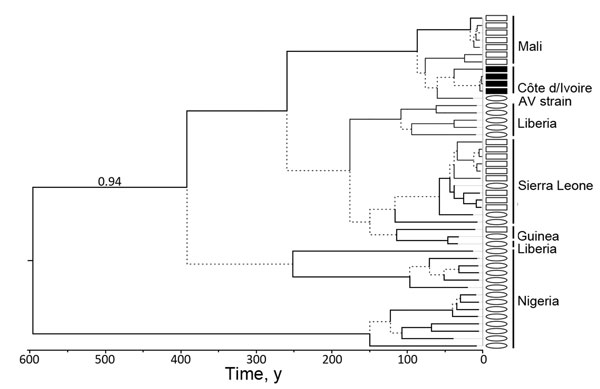Lassa Virus in Multimammate Rats, Côte d’Ivoire, 2013
Leonce Kouadio, Kathrin Nowak, Chantal Akoua-Koffi, Sabrina Weiss, Bernard K. Allali, Peter T. Witkowski, Detlev H. Krüger, Emmanuel Couacy-Hymann, Sébastien Calvignac-Spencer, and Fabian H. Leendertz

Author affiliations: Robert Koch Institut, Berlin, Germany (L. Kouadio, K. Nowak, S. Weiss, S. Calvignac-Spencer, F.H. Leendertz); Laboratoire Central de la Pathologie Animal, Bingerville, Côte d’Ivoire (L. Kouadio, E. Couacy-Hymann); Université Alassane Ouattara de Bouake, Bouake, Côte d’Ivoire (C. Akoua-Koffi); European Centre for Disease Prevention and Control, Stockholm, Sweden (S. Weiss); Public Health England, London, UK (S. Weiss); Institut Pasteur de Côte d'Ivoire (B.K. Allali); Charité School of Medicine, Berlin (P.T. Witkowski, D.H. Krüger)
Main Article
Figure

Figure. Bayesian chronogram of Lassa virus (LASV) sequences determined on the basis of a fragment of the large genomic segment. Branches receiving posterior probability values <0.95 and bootstrap values <50 (poorly supported) are dashed. LASV sequences of human origin are indicated by ovals, and those of multimammate rats are indicated by squares. Sequences reported in this study are indicated by black squares. This tree was built under the assumption of a molecular clock and is therefore rooted. The numerical value on the tree’s most basal branch is the root posterior probability of this branch; it supports the notion that LASV sequences from Nigeria and other countries are not reciprocally monophyletic. GenBank accession nos. of sequences used for phylogenetic analyses are shown in Technical Appendix Table 2. AV strain indicates the strain from a German patient.
Main Article
Page created: July 15, 2015
Page updated: July 15, 2015
Page reviewed: July 15, 2015
The conclusions, findings, and opinions expressed by authors contributing to this journal do not necessarily reflect the official position of the U.S. Department of Health and Human Services, the Public Health Service, the Centers for Disease Control and Prevention, or the authors' affiliated institutions. Use of trade names is for identification only and does not imply endorsement by any of the groups named above.
